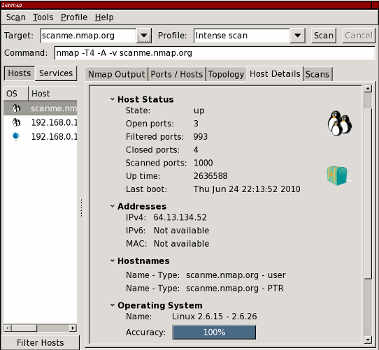

On Windows Vista or later versions of Windows, you may be asked to provide permission for Zenmap to make changes to your computer. After downloading, run zenmap-VERSION.exe to start Zenmap. Zenmap can be downloaded by clicking here or you can download it from its official download page. It performs more than just port scanning it also supports version detection, service detection, identifying MAC addresses of devices connected to local networks of different protocols, and doing basic traceroute functionality.
#INSTALL ZENMAP MAC OS#
Zenmap does not need any special hardware requirements and works on almost all operating systems including Windows, Mac OS X, and Linux. Zenmap is a graphical user interface for performing advanced network scan tasks easily. It was created to enable users of all skill levels to easily explore networks and conduct security audits. Zenmap is the official network scanner of the Nmap Security Scanner and has many powerful features including identification of thousands of OS fingerprints, detection of hundreds of protocols, support for IPv6, decoy/stealth scanning, external script scanning, and more. It has been designed to rapidly scan large networks but works fine against single hosts. Zenmap is an advanced network scanner designed to discover hosts and services on a computer network, thus creating a map of the network.
#INSTALL ZENMAP INSTALL#
Step #6: Download and Install Some Additional Python Tools.
#INSTALL ZENMAP UPDATE#
Step #3: Update and Upgrade Your System.Step #2: Remove Any Existing Installation of Zenmap (Optional).Zenmap Download & Installation Steps in Linux.Leaving vulnerable networking ports open is dangerous, even with a steller, safe OS like Linux. Having ports like this open is a great way for intruders to gain unwanted access to your Linux PC. If you’re curious about that state of ports on your Linux PC, or other network devices on your network, you may want to scan open ports and close the ones you’re not using. When it comes to port scanning, Zenmap is king. The program is by far the most well-known graphical front-end for Nmap on Linux. Many people in the security industry use it, and as a result, it is simple to install on most mainstream Linux operating systems.
#INSTALL ZENMAP SOFTWARE#
The software is usually found in mainstream distribution’s package repositories. To install it, open up a terminal and follow the instructions below depending on your OS of choice. On Ubuntu, users can quickly get the latest version of Zenmap working without much trouble as Canonical makes it available in the main software sources. Open up “Ubuntu Software Center,” search for “Zenmap”, and select the “Install” button. Otherwise, use this command in terminal: sudo apt install zenmap Debianĭebian has a version of Zenmap that is available for easy installation via the included software sources. However, keep in mind that this version is out of date due to the nature of Debian. If you’re in need of a newer version of Zenmap than what is included with Debian Stable proper, check out Debian Backports. On Arch Linux, there isn’t an official “Zenmap” package in the software repositories. Instead, Arch users looking to use the GUI frontend for Nmap will need to install the nmap package via Pacman. Installing this package will also install Zenmap. sudo pacman -S nmap Fedoraįedora Linux doesn’t have a “Zenmap” package. Instead, Fedora users looking to use the Zenmap tool will need to install nmap-frontend. sudo dnf install -y nmap-frontend OpenSUSE Open up a terminal and use the DNF packaging tool to install Zenmap. OpenSUSE distributes Zenmap via the “OSS all” software repository. Once it is enabled, use the Zypper package manager to install it to the system. Zenmap may be in your distribution’s software sources. To install, search for “zenmap” and install it. Alternatively, follow these instructions to build it from source. Step 1: run wget to download the latest source-code of Zenmap.

Step 2: extract the source code from the Tar archive. Step 4: build and install the program./configure Step 3: use the CD command to enter the source code folder.


 0 kommentar(er)
0 kommentar(er)
